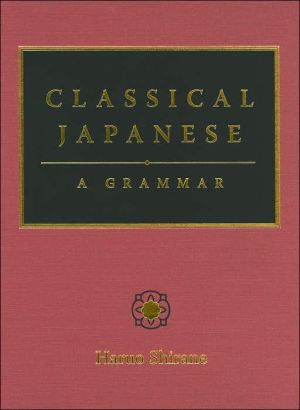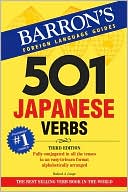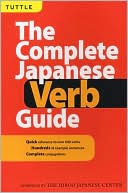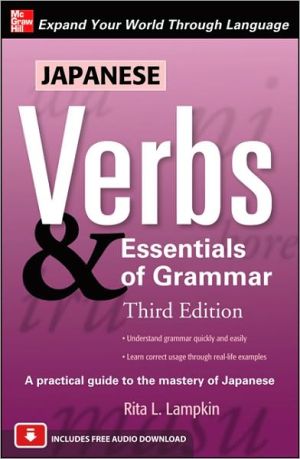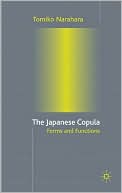Classical Japanese: A Grammar
Classical Japanese: A Grammar is a comprehensive, and practical guide to classical Japanese. Extensive notes and historical explanations make this volume useful as both a reference for advanced students and a textbook for beginning students. The volume, which explains how classical Japanese is related to modern Japanese, includes detailed explanations of basic grammar, including helpful, easy-to-use tables of grammatical forms; annotated excerpts from classical premodern texts.\ Classical...
Search in google:
Classical Japanese: A Grammar is a comprehensive, and practical guide to classical Japanese. Extensive notes and historical explanations make this volume useful as both a reference for advanced students and a textbook for beginning students. The volume, which explains how classical Japanese is related to modern Japanese, includes detailed explanations of basic grammar, including helpful, easy-to-use tables of grammatical forms; annotated excerpts from classical premodern texts, with accompanying grammar and vocabulary notes; and exercises and an answer booklet.
PrefaceElements of the BookGrammatical Terms and TranslationsMajor Historical PeriodsRomanizationSource and Text AbbreviationsTranslations of Ranks and TitlesPart I Inflected Forms1. Basic Grammatical Terms and Concepts1.1 Subject and Predicate1.2 Sentence Structure1.3 Autonomous and Dependent Forms1.4 Inflected and Noninflected Forms1.5 Inflected Autonomous Words1.6 Inflected Dependent Forms1.7 Noninflected Dependent Forms1.8 Noninflected Autonomous Words1.9 Modifying Words1.10 Parts of Speech2. Orthography and Pronunciation2.1 Table of Fifty Sounds2.2 Voiced Sounds2.3 Sound Changes2.4 Pronouncing Historical kana2.4.1 w-Row Pronunciation2.4.2 h-Row Pronunciation2.5 Pronouncing Long Sounds3. Verbs3.1 The Six Inflected Forms3.2 Regular Verbs4. Irregular Verbs4.2 Transitive and Intransitive Verbs4.3 Supplementary Verbs4.4 Sound Changes in Verbs5. Adjectives and Adjectival Verbs5.1 Adjectives5.2 Adjectival Verbs5.3 Two Modifying Functions6. Negative and Recollective Auxiliary Verbs6.1 Negative zu6.2 Auxiliary Verbs ki and keri7. Perfective and Continuative Auxiliary Verbs7.1 Auxiliary Verbs nu and tsu7.2 Resultative-Continuative Auxiliary Verbs tari and ri8. Copular Auxiliary Verbs9. Auxiliary Verbs of Speculation and Supposition9.1 mu9.2 muzu9.3 kemu9.4 ramu9.5 rashi9.6 mashi9.7 beshi9.8 meri9.9 Hearsay nari9.10 Summary of the Basic Functions of Speculative Auxiliary Verbs10. Negative Speculative, Desirative, and Comparative Auxiliary Verbs10.1 NegativeSpeculative Auxiliary Verbs ji and maji10.2 Desirative Auxiliary Verbs tashi and mahoshi10.3 Comparative Auxiliary Verb gotoshi11. Passive-Causative Auxiliary Verbs11.1 ru, raru11.2 su, sasu, shimu11.3 Summary of Auxiliary VerbsPart II Noninflected Forms12. Case Particles12.1 ga12.2 no12.3 o12.3A o-ba12.4 ni12.5 e12.6 to12.7 yori12.8 kara12.8A kara-ni12.9 shite12.10 nite13. Conjunctive Particles13.1 ba13.2 to, tomo13.3 do, domo13.4 ni, o13.5 ga13.6 te, shite13.6A zu-te13.6B te-wa13.6C Conjunctive Particle te plus Supplementary Verb13.7 de13.8 tsutsu13.9 nagara13.10 mono-o, mono-kara, mono-no, mono-yue13.11 Summary of Connections14. Bound Particles14.1 wa14.2 mo14.2A mo at the End of a Sentence14.3 zo14.3A zo at the End of a Sentence14.4 namu (nan)14.5 ya (yawa)14.5A ya (yawa) at the End of a Sentence14.6 ka (kawa)14.6A ka (kawa) at the End of a Sentence14.7 koso14.7A A Bound Ending Without a Bound Particle15. Adverbial Particles15.1 sura15.2 dani15.3 sae15.4 nomi15.5 bakari15.6 nado15.7 made15.8 shi, shimo15.9 Note on Adverbial Particles Versus Adverbs16. Final and Interjectory Particles16.1 Final Particles16.2 Interjectory Particles16.3 Bound Particles at the Ends of Sentences17. Nouns, Pronouns, Adverbs, Interjections, Conjunctions, and Attributive Words17.1 Nouns17.2 Pronouns17.3 Adverbs17.4 Interjections17.5 Conjunctions17.6 Attributive WordsPart III Honorifics18. Honorific Expressions18.1 Noninflected Honorifics18.2 Honorific Supplementary Verbs18.3 Honorific Verbs18.4 Honorific Auxiliary Verbs19. Humble and Polite Expressions19.1 Humble Verbs19.1.1 tatematsuru19.2 Mixing Honorific and Humble Forms19.3 Summary of Key Honorific and Humble Verbs19.4 Polite Verbs20. Nara-Period Grammar20.1 Auxiliary Verbs20.2 Case Particles20.3 Final Particles20.3.1 kamoPart IV AppendixesAppendix 1. Review of the Six InflectionsAppendix 2. Overview of Sound ChangesAppendix 3. Prefixes and SuffixesAppendix 4. Supplementary VerbsAppendix 5. Rhetorical Techniques in Japanese PoetryAppendix 6. Easily Confused ElementsAppendix 7. Auxiliary Verb CombinationsAppendix 8. Conjugational ShiftsA8.1 The Disappearance of Conjugation TypesA8.2 The Growth of the Rentaikei FormA8.3 New Adjectival FormsPart V Grammar ExercisesTables of Grammatical FormsTable 1. Verb ConjugationsTable 2. Adjectives and Adjectival Verb FormsTable 3. Sound ChangesTable 4. Auxiliary Verb ConjugationsTable 5. Auxiliary Verb Types and FunctionsTable 6. Auxiliary Verb ConnectionsTable 7. ParticlesTable 8. Main Functions of Inflected Forms
\ Columbia College TodayThis comprehensive guide... includes in-depth explanations, exercises and literary excerpts useful to beginners as well as advanced speakers.\ \ \ \ \ \ Monumenta NipponicaA significant contribution to the field of premodern Japanese language and literary studies.\ — Stephen D. Miller\ \ \ \ Monumenta Nipponica\ - Stephen D. Miller\ A significant contribution to the field of premodern Japanese language and literary studies.\ \ \
